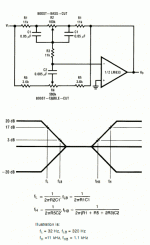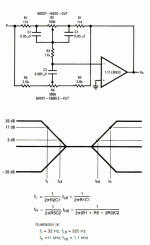Hi all. I look for a Baxandall tone control circuit, which can control bass and treable on 20dB or more. My english is not good I know sorry
Hi all. I look for a Baxandall tone control circuit, which can control bass and treable on 20dB or more. My english is not good I know sorry
Hi
Your English is good enough:🙂
I hope this helps.
Max bass boost = (R1+R2) / R1
Max bass cut = R1 / (R1+R2)
Max treble boost = (R5+R1+2*R3) / R5
Max treble cut = R5 / (R5+R1+2*R3)
R4 shall be larger or equal to 10*(R5+R1+2*R3)
R2 shall be much larger than R1
In the example circuit:
Max bass boost = 20*log ((11k+100k)/11k) = 20dB
Max bass cut = 20*log (11k / (11k+100k)) = - 20dB
Max treble boost = 20*log ((3.6k+11k+2*11k) / 3.6k) = 20dB
Max treble cut = 20*log (3.6k / (3.6k+11k+2*11k)) = -20dB
Attachments
It look easier than it seem. Is possible use transistor on the way out, because operations amplifier and another integrate circuit is not allow for my poject.
additional informations and weblinks you can find here:
http://www.diyaudio.com/forums/solid-state/92121-need-equation-3-band-baxandall-equalizer.html
http://www.diyaudio.com/forums/solid-state/92121-need-equation-3-band-baxandall-equalizer.html
It look easier than it seem. Is possible use transistor on the way out, because operations amplifier and another integrate circuit is not allow for my poject.
Hi mckvak
Yes it is possible to use transistors instead of an opamp.
Maybe you should post the circuit you have made so far, that you would like to use the tone control with. If you have a gain stage maybe you should try to implement the tone control around that stage, or you could use a passive tone control.
stinius
This is the circuit. But way out sign as REC out I will not use
An externally hosted image should be here but it was not working when we last tested it.
There are diagrams where instead of R5 is a capacitor let's say about 1.8 or 3.3nF in series with the treble potentiometer and even if instead of C2 in some diagrams appears a fix rezistor. How can you calculate in this case? Another diagrams omit even R5 and the treble potentiometer (R4) is connected directly in paralel with R1-R2-R1. Which is the formula for this case? Thank you!
With that calculator you can calculate for passive Baxandall. I heard that a capacitor has a reactance.. Let's say 100nF ~ 6.8K rezistor..
How is modified the formula for the casese when there are capacitors?
How is modified the formula for the casese when there are capacitors?
good question.
Unfortunately no reply.
Anywhere in the japanese magazine MJ this topic was discuss.
Maybe members from Japan can find out this and translate for us.
http://www.diyaudio.com/forums/soli...sen-jikken-yearly-index-1924-2009-wanted.html
Unfortunately no reply.
Anywhere in the japanese magazine MJ this topic was discuss.
Maybe members from Japan can find out this and translate for us.
http://www.diyaudio.com/forums/soli...sen-jikken-yearly-index-1924-2009-wanted.html
Last edited:
a while ago i played a bit with passive tone control simulator on Duncan site
it can cause really weird curves and bad effects if wrong values are chosen
I would be very careful with those things
are active controls equally tricky ?
btw, someone experienced with this stuff mentioned that passive controls cause much less bad side effects than active feedback controls
adding gain I believe is a different game, and does not make it active as such
it can cause really weird curves and bad effects if wrong values are chosen
I would be very careful with those things
are active controls equally tricky ?
btw, someone experienced with this stuff mentioned that passive controls cause much less bad side effects than active feedback controls
adding gain I believe is a different game, and does not make it active as such
Update : Active Baxandall calculator (online soft) Active BAXANDALL
What is the meaning of Al and Ah on this caluclator? 🙂
- Status
- Not open for further replies.
- Home
- Amplifiers
- Solid State
- Baxandall tone control circuit

